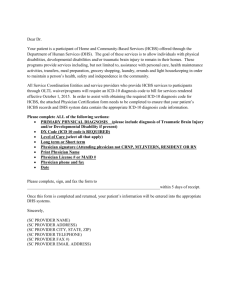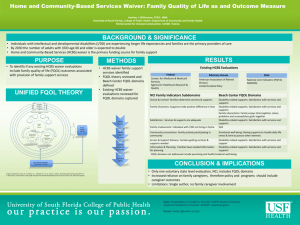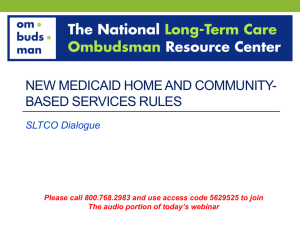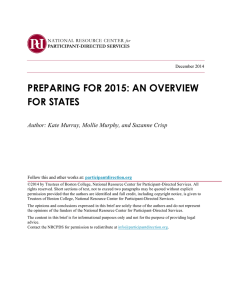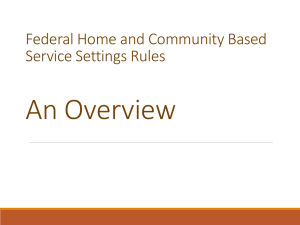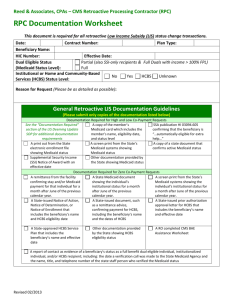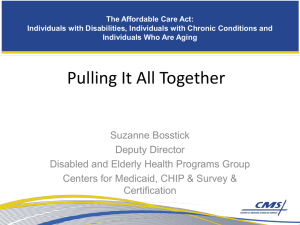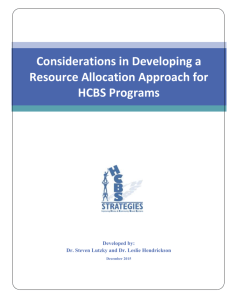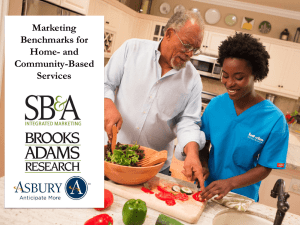State Support for Home and Community-Based Services and Elderly Well-Being
advertisement
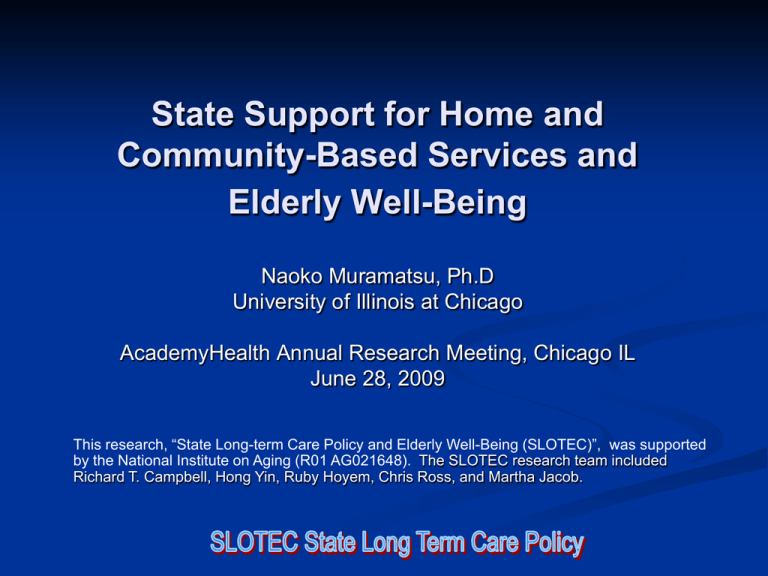
State Support for Home and Community-Based Services and Elderly Well-Being Naoko Muramatsu, Ph.D University of Illinois at Chicago AcademyHealth Annual Research Meeting, Chicago IL June 28, 2009 This research, “State Long-term Care Policy and Elderly Well-Being (SLOTEC)”, was supported by the National Institute on Aging (R01 AG021648). The SLOTEC research team included Richard T. Campbell, Hong Yin, Ruby Hoyem, Chris Ross, and Martha Jacob. Home & Community-Based Services (HCBS) U.S. has made progress towards expanding HCBS. Personal care, adult-day care, nutrition and transportation services, etc. Intended to help persons with disabilities avoid institutionalization. States Vary in HCBS Support Funding sources Medicaid (state plan, waiver) Older Americans Act Social Services Block Grants State general funds HCBS expenditures per person 65+ 2002 Average: $375 Range: $30 (TN) - $1080 (NY) Study Questions Does living in a state supportive of HCBS make a difference in elderly well-being? 1. 2. Psychological well-being (depression) Chance of aging in the community ↓Nursing home admission Return to community from nursing home Dying at home Data Person-level: Health and Retirement Study (HRS) Five-wave panel data (1993-2002). National representative samples of noninstitutionalized adults aged 70 + as of 1993 State-level: HCBS support (total HCBS $) County-level: LTC service availability Analytic Approaches Multilevel repeated measures analysis (depressive symptoms) Discrete-time survival analysis (nursing home admission and discharge) Multilevel logistic regression (chance of dying at home) Controls: respondents’ demographic, social, economic, health and caregiving resources that change over time. Does living in a state supportive of HCBS make a difference in elderly well-being? 1. 2. Psychological well-being (depression) Chance of aging in the community ↓Nursing home admission Return to community from nursing home Dying at home Stress Process Model Declining physical and cognitive function stressful for seniors & spouse Consistently low function: chronic stress Recent/rapid declines: acute stress Stress depressive symptoms Caregiving contexts modify stress process Non-spouse family availability State HCBS support States’ HCBS & Psychological Well-Being Stress of functional limitations 1 Chronic stress: indiv means • I/ADL Depressive Symptoms • Cognition (Yes/no) 2 Acute stress: changes Resources: Care-giving Contexts • Non-spouse care availability • State HCBS support 1.1 State HCBS Protects Seniors from Chronic Stress of Functional Limitations Predicted probability of depression .6 .5 .4 8 limitations 7 6 5 4 3 2 1 0 .3 .2 .1 0 $28 $76 $206 $561 $1230 State HCBS expenditures (logged) Chronic stress: Intra-person means of I/ADL limitations; underlying levels of function) Two-way interaction between state HCBS & mean ADL/IADL 1.2 State HCBS Protects Seniors from Acute Stress of Functional Limitations Predicted probability of depression .4 .3 7 more limitations 6 5 4 3 2 1 0 1 less limitations .2 .1 0 $28 $76 $206 $561 $1230 State HCBS expenditures (logged) Acute stress: changes in I/ADL from one’s underlying level of function Two-way interaction between state HCBS & I/ADL changes 1.3 State HCBS Protects Seniors without Family Help Predicted probablity of depression from Chronic Stress of Severe Cognitive Limitations Have family help No family help .2 .1 0 $28 $76 $206 $561 $1230 $28 $76 $206 $561 $1230 State HCBS expenditures (logged) 90 percentile (High cognitive impairment) 75 percentile 50 percentile 20 percentile 10 percentile (Low cognitive impairment) Three-way interaction among state HCBS, mean cognition & non-spouse family availability Does living in a state supportive of HCBS make a difference in elderly well-being? 1. 2. Psychological well-being (depression) Chance of aging in the community ↓Nursing home admission Return to community from nursing home Dying at home States’ HCBS & Chance of Aging In Community State-level HCBS support Nursing home admission • First • End-of-life County-level health resources Place of death Individual-level factors Socio-demographic Health & function Family availability Individual-level end-of-life status Socio-demographic Cause & timing of death Health Family availability 2.1 State HCBS Delays/Prevents First Nursing Home Admission (>=90 days) among Childless Seniors Discrete Time Survival Model (HRS, cohort born 1923 or earlier) ‘93-’02 Source: Muramatsu, et al., 2007. “Risk of Nursing Home Admission among Older Americans: Does States’ Spending on Home and Community-Based Services Matter?” Journal of Gerontology: Social Sciences, 62(3):S169-178. 2.2 State HCBS Support, Home Deaths, & Community Discharges from Nursing Homes State HCBS ↓ risk of end-of-life nursing home relocation* Increased Chance of Dying at Home* State HCBS not associated with return to community for nursing home residents. *Source: Muramatsu, et al. 2008. “Place of Death among Older Americans: Does State Spending on Home- and Community-based Services Promote Home Death?” Medical Care 46(8): 829-838. Conclusion Where seniors live matters for their wellbeing: living in a state with higher HCBS support was associated with greater wellbeing among community-dwelling seniors with functional limitations, especially among those with limited family support. Policy Implications This study provides evidence for the importance of continued state and federal efforts to sustain and increase HCBS funding. Aging baby boomers with fewer children. Proportion of those who lack family caregivers and the role of HCBS will continue to grow. Political will is needed to prepare society for increasing LTC needs, especially at this time of economic hardship.
